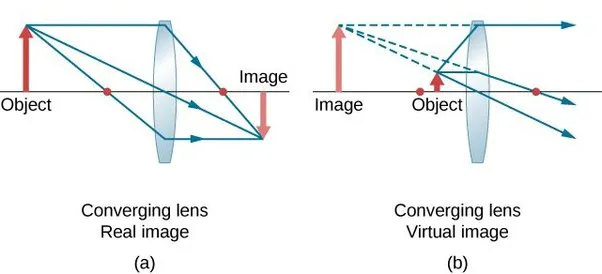Lenses
Lenses are cool optical devices that use refraction to scatter or focus light. They can be made of glass or plastic and come in two main types: simple and compound. Simple lenses have one transparent part, while compound lenses have several. You can find lenses in things like telescopes, binoculars, and cameras. Some lenses are curved inwards (concave) and others are curved outwards (convex), depending on what they're used for. Unlike a prism that just bends light, lenses can make an image by focusing light.
Concavity and convexity
When light strikes a lens, it can either converge or diverge. Converging lenses have two curved sides that bend inward and focus light onto a focal point. These lenses can create both real and virtual images on a screen. Our own eyes also have convex lenses. On the other hand, diverging lenses have curved sides that bend outward and spread out light rays. The principal axis is a line that runs through the center of the lens and is perpendicular to it. Light rays parallel to this axis converge at the focal point F. The focal length is the distance between the lens center and the focal point. The shape of the lens affects the focal length, with shorter focal lengths requiring a more curved lens.
The lens of the eye
The eye's lens is really cool! It bends light rays from an object and focuses them on the retina. But did you know that the lens actually changes shape to do this? That's right, the muscles connected to the ligaments and ciliary muscles move the lens to alter its curvature and size. This is called accommodation, and it lets the eye focus on objects at different distances. A more curved surface means a stronger focusing power, which is measured in dioptres (D). Converging lenses have positive power, while diverging lenses have negative power. When you add up the refracting powers of multiple lenses or surfaces, you get their total refracting power.

Ray diagrams
To determine where an image will form with a lens of known power, a ray diagram can be used. The diagram shows a straight vertical line to represent the lens axis, a horizontal line for the primary axis, and dots on the principal axis to indicate the focal point F on each side of the lens. An object is represented as an arrow on the principal axis, drawn to scale. Three distinct rays emerge from the object, and their passage through the lens is anticipated based on certain criteria. By tracing these rays, the focused image can be located, also to scale. In the diagram, one ray passes through the optical centre without being refracted, while a ray parallel to the principal axis refracts through the lens and passes through the focal point on the other side. Finally, a ray travelling from the focal point to the lens refracts through the lens and continues parallel to the principal axis. All ray direction changes are shown only at the lens axis.

The lens formula
The lens formula is another method for calculating the location of a focused image. The formula relates the focal length, f, of a lens to the object distance, u, and the image distance, v. The formula is:
1/f = 1/u + 1/v
When using the lens formula, there is a sign convention to be aware of. It is possible to have a negative image distance, v. In this case, the image is virtual, on the same side of the lens as the object, and upright if the value of v is negative. When the object distance is smaller than the focal length, a virtual image is formed on the same side of the lens as the object. This is shown in the diagram for convex lenses.

Magnification
A lens’s image might be smaller or larger than the object it is forming. The ratio of image height to object height determines the magnification of an image generated by a lens. So, in the figure below, we have:

In addition to the sign convention for image distance and magnification, there are a few other key takeaways when it comes to. A converging lens is one that is convex and has the ability to produce a real image if the object distance is greater than the focal length. The human eye's lens is an example of a converging lens. On the other hand, a diverging lens is a concave lens that forms a virtual image. The power of converging lenses is positive, while the power of diverging lenses is negative. Finally, the process by which the eye adjusts the power of its lens to maintain a focused image for objects at varying distances is known as accommodation.
Lenses
What are the types of lenses?
There are two types of lenses, i.e., diverging (concave) lenses and converging (convex) lenses.
What are contact lenses made of?
Soft contact lenses are made of hydrophilic plastic, while hard contact lenses are made of a material called polymethyl methacrylate.
What are polarised lenses?
Polarised lenses are the lenses that help reduce glare and provide additional security to keep the eyes protected.


















